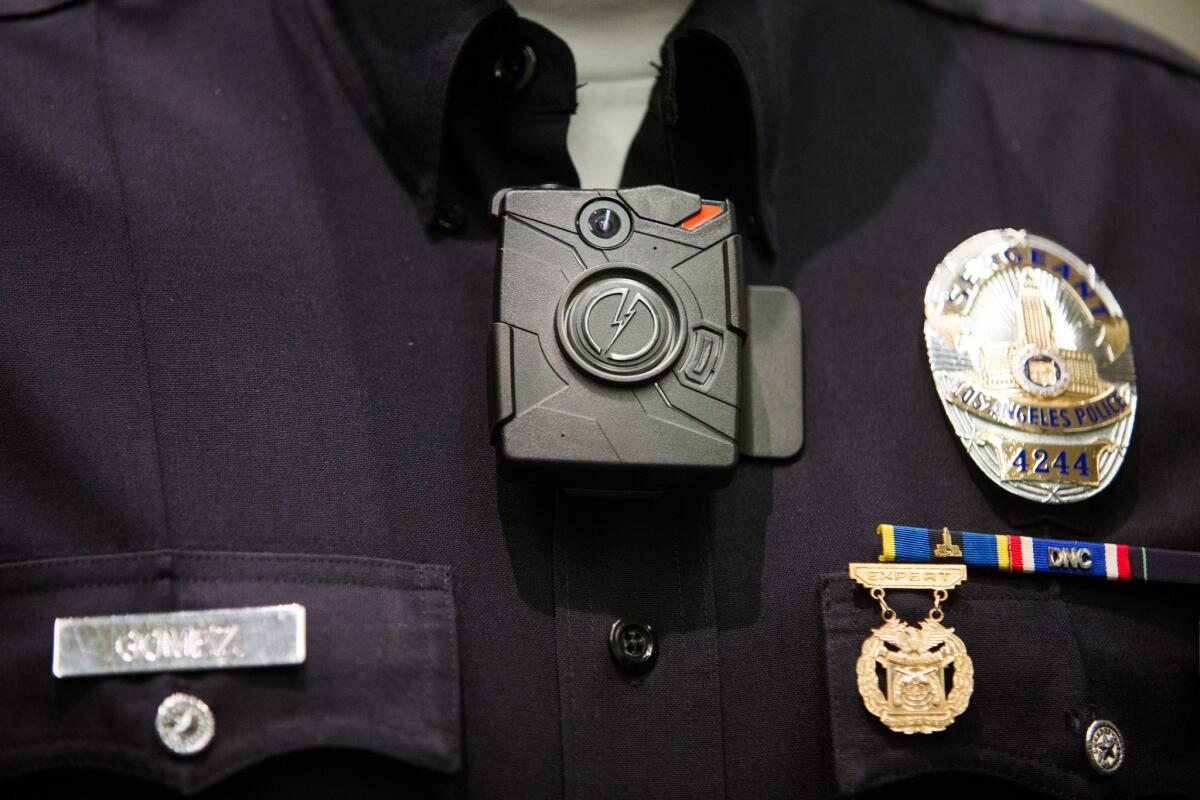Editorial: Police body cams are for restoring public faith in law enforcement, not surveillance

- Share via
The best thing about police body cameras is that they capture images of law enforcement encounters with members of the public, including suspects, witnesses and passersby. The recordings help keep all parties honest and allow them to gain some confidence in one another, knowing that anything anyone says about the interaction can later be verified.
There also may be some public safety value to another technology — facial recognition. It can analyze a person’s features to compare with profiles stored in a database, like the one compiled from Department of Motor Vehicle licenses. Digital “faceprints” created by image recognition systems can be used to help find lost people with Alzheimer’s disease, for instance. Or criminal suspects. Or anyone.
Now some police agencies are looking into combining the two technologies, putting body cam recordings through facial recognition analysis.
That would make every cop a spy post. It would make every body cam a spot for personal data to be compiled, stored and analyzed without the permission of the recorded subjects. And it would do so even if those subjects are not suspected of any wrongdoing.
Facial recognition, combined with body cam images, can be misused. It can track each individual’s whereabouts at any given time and keep that data in permanent registries for later use. It can even be used for continuous surveillance of an entire community.
It’s a very bad idea. It would undermine the whole point of body cameras, which was to restore confidence in police.
Technology by itself is just technology — an assortment of tools that enhance human power. The keys to its benefits and dangers are the laws that dictate how the power can be wielded. Body cams, for example, could easily erode rather than enhance confidence in police if the cops alone had access to the images and if only they could control their use. Accordingly, the Los Angeles Police Department and some other agencies adopted rules that require public release of captured body cam images within a few weeks of an encounter. The Legislature followed suit last year by mandating that any law enforcement agency that uses body cameras make images similarly available to the public.
Lawmakers are now considering a bill that would ban the use of facial-recognition technology in conjunction with body camera images. AB 1215 cleared the Assembly and is now pending on the floor of the Senate.
Some police groups oppose the bill on the argument that the state should not block them from using tools that make it easier to fight crime and identify lawbreakers.
And it is true that there is a balance that society needs to strike between privacy — being free of state intrusions into one’s private life and being assured that seeing a police officer doesn’t automatically mean entering your personal information into some digital database — and public safety. San Francisco fell short of a smart balance earlier this year when it banned government use of all facial recognition technology in that city for all purposes. The instinct to simply ban new or intimidating technologies is understandable, but we could all benefit from a more thoughtful approach.
Besides, some types of surveillance are facts of modern life and will become only more ubiquitous. You can shell out a few bucks right now for internet-linked security cameras that can tell you, wherever you are, who is at your door. That kind of technology is not going away.
You can also share those collected images with your local police department, which can then use them for their own public-safety — or surveillance — purposes. Numerous package thieves have been caught through use of recorded door images that were shared with police.
But should users of those systems be required to share those images with police? That’s another matter altogether. Laws should be crafted to ensure that technologies — and government — serve the public and not the other way around.
The bill to ban the use of facial recognition technology in conjunction with police body cameras correctly keeps the public in charge. It is a natural extension of last year’s bill to ensure that body camera recordings are ultimately accessible by the public. It ensures that body cameras continue to work as intended — to enhance confidence in law enforcement — instead of shifting the power of technology from the public back to the police.
More to Read
A cure for the common opinion
Get thought-provoking perspectives with our weekly newsletter.
You may occasionally receive promotional content from the Los Angeles Times.










